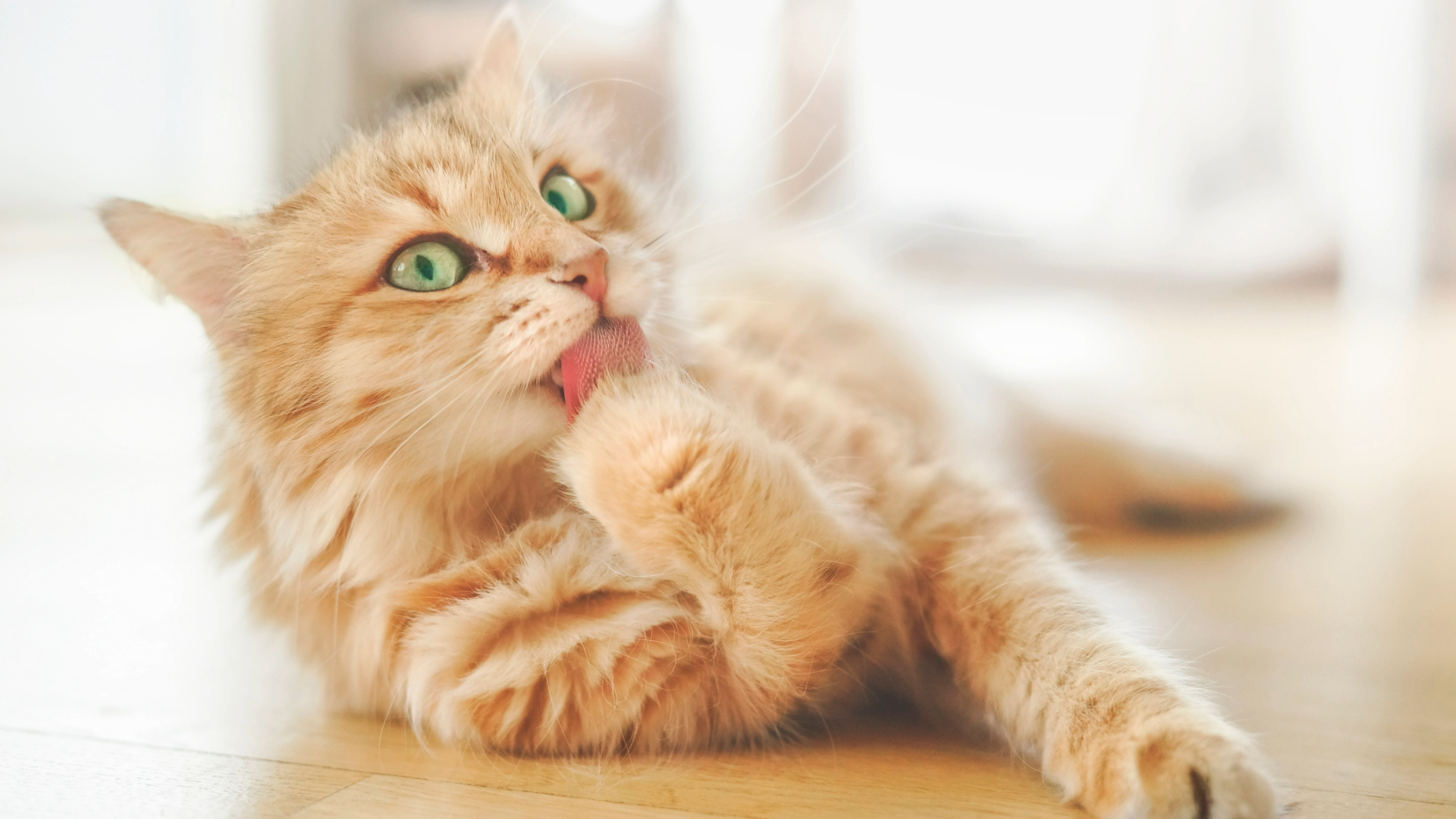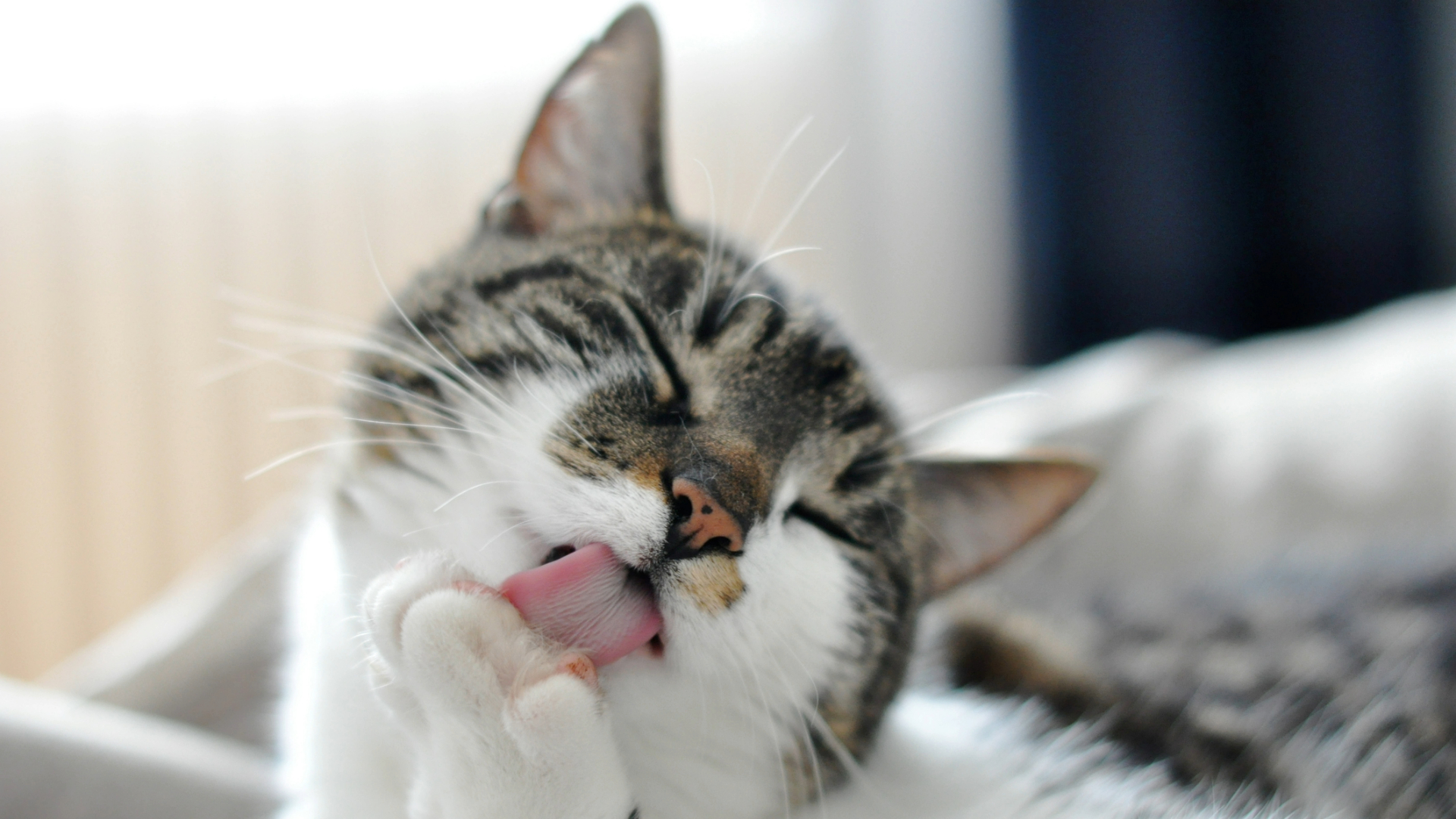Why is my cat overgrooming? Vet nurse explains the causes and how to help
A cat constantly licking and nibbling at their fur can be stressful to live with, leading to you to wonder, ‘Why is my cat overgrooming?’

Cats love to groom and keep themselves clean; looking pristine is of the utmost importance to felines but, ‘Why is my cat overgrooming?’ you ask. And, ‘When is too much too much?’
I am an advanced surgical veterinary nurse. I have also written veterinary academia, pet care books and feature articles since 1999. Throughout my career in veterinary practice and in the pet care industries, overgrooming in cats is something I saw a lot. It’s understandable to be concerned, particularly if you are noticing hair loss on your kitty as well, but worry no more. Join me as we taxi through when and why normal grooming becomes overgrooming, the problems overgrooming causes, and how you can help your cat.
Before we jump right into it, take a moment to consider your cat’s diet. A complete and good-quality feline diet is essential in helping treat most issues, this is especially so in maintaining your cat’s hair and skin in top condition. If you have a young kitten, do check out the best kitten food for them or if your cat is all grown up, browse the best cat food for your adult kitty.
What does cat overgrooming look like
It is normal for a cat to groom regularly; this is a daily healthy habit they partake in. It is well documented, as the Cornell Feline Health Centre reports, that cats will spend 30% to 50% of their day grooming and this is classed as a normal amount of time spent on this essential activity. Cats groom themselves often by licking their fur, nibbling, and rubbing their front paws over their heads and front quarters.
Overgrooming, however, occurs when your cat spends an abnormal amount of time and attention on grooming. At first, this may appear acceptable and can go unnoticed, but it soon leads to hair thinning, hair loss, and skin sores (skin lesions). Bald or thinning patches due to overgrooming feel rough and spiky to the touch, as the hair shaft has been broken off mid-way by the grooming.

This is in contrast to the smooth-feeling bald patches you’ll notice in alopecia not related to overgrooming. You may notice these roughened bald strips along the insides of their legs, under the abdomen, or on their back.
Cats might also chew or bite their tails - this type of overgrooming can cause soft tissue damage or mutilation, according to the Journal of Feline Medicine and Surgery.
Get the best advice, tips and top tech for your beloved Pets
Excessive licking, nibbling, biting, chewing, and scratching are all problematic signs that your kitty is overgrooming and requiring your intervention. Aside from secondary hair loss and skin issues, overgrooming may also cause the increased occurrence of hairballs in cats due to all the extra hair they are swallowing.
Why is my cat suddenly obsessively grooming?
At around five weeks old, a kitten will begin to start grooming themselves, a natural behavior that continues for life. Cats self-groom not only because it produces endorphins (the feel-good neurotransmitters) but because it helps to regulate their body temperature, and assists in the elimination of parasites, infections, and allergies (thereby also aiding the prevention of traumatic skin conditions like dermatitis or hot spots in cats).
It also stimulates their circulation and distributes skin oils too. Like everything in life though, too much causes damage and if your kitty is suddenly overgrooming, the following causes could be the reason. A trip to your vet is advised as soon as you spot any overgrooming habits.
1. Stress (behavioral)
Excessive grooming is usually caused by stress and this is a very common cause of hair loss in cats. When a cat has become stressed, anxious, fearful, or worried, they might groom themselves to feel better and safer as it releases happy endorphins.
Stress, fear, or anxiety in cats can occur for many reasons from a new pet in their home, outside roadworks, a new food to boredom, or a house move.

2. Allergies and skin infections
Allergies may be environmental, parasitic (flea allergic dermatitis FAD for example), seasonal, or food-related. Common allergies in cats frequently react on the skin making it itchy, uncomfortable, and irritating. When skin is disrupted due to an allergy or a bacterial skin infection, cats will go into overgrooming mode in a bid to relieve discomfort and heal it.
Fleas cause a specific allergy in cats known as flea-allergic dermatitis. Your cat isn’t allergic to the flea but the flea’s saliva, which is injected into your cat’s skin when the flea bites them for a feed.
Signs of allergies (regardless of the originating cause) include red/pink skin, thinned hair, bald patches, scabby areas, itchy ears, ear infections, paw and nail licking and biting, behavioral changes, scratching, rubbing of body parts on furniture or the floor, disturbed sleep or rest, lethargy, and gastrointestinal problems.
NaturVet Aller-911 Allergy Aid Anti-Lick Paw Plus Aloe Vera Dog & Cat Spray
If your pet is constantly licking and irritated by their paws, it can be a sign of allergies, pain, or irritated skin. The persistent need for licking is not only distressing to your pet, but it can cause further skin infections whilst delaying the healing of current issues. This anti-lick spray helps to soothe any inflamed skin and discourages them from licking, therefore allowing the situation to resolve.
3. Pain
Cats who are in pain or discomfort will lick or nibble at the area in question. The source of pain may arise for different reasons, for example, a wound sustained when out climbing trees or a fracture from a road accident. Older cats are susceptible to conditions like arthritis which makes their joints ache, or they may have another underlying health condition causing skeletal or muscle pain.
How do I stop my cat from overgrooming?
Once you are aware your cat is overgrooming, a trip to your vet is required to rule out any medical issues. After that, behavioral problems can be investigated and addressed. Either way, an appropriate treatment plan can be put together to help your cat and it may consist of one or few of these methods. The right one of course will depend on the cause of the overgrooming.

1. Administer any medication or treatment as prescribed by your vet. This may vary from parasite treatment to antibiotics to pain relief to creams. It all depends on the reason for the overgrooming. In some cases, wounds for example, surgical procedures may be required.
2. Use anti-anxiety medications such as pheromone sprays and plugins. These help to calm your kitty by emitting a synthetic version of the natural pheromones a cat releases when they are happy, therefore helping to quell anxiety and stress.
NaturVet Quiet Moments Feline Pheromone Calming Spray for Cats
A convenient and portable spray that may help any anxious or stressed cat over three months old. Containing a synthetic version of the cats’ natural pheromone, it can be used around the home, on their bedding, in their carrier, or inside the car. The pheromone mimics the one a cat naturally emits when they feel secure and joyful. A calm cat equals a happy cat!
3. Rectify environmental stressors. This can be tough as it can be many things but once the culprit is identified it makes life easier! If they are stressed over their feeding bowl (they don’t like the smell of plastic let's say), then swap it for a ceramic one. Have you changed their litter? More complex behaviors due to newcomers in the household or a new home may require advice from a cat behaviorist or your vet. Remove the trigger, if possible, don't punish them, and try to make your cat feel as safe and secure as possible.
4. Incorporate preventative flea and worming treatment to avoid parasitic problems. Ensure you are regularly grooming them too. This not only helps their coat but provides bonding opportunities and the chance to monitor their skin and fur for any signs of issues. You can also take your cat to a professional groomer. Consult the National Cat Groomers or your local groomer for more information.
Understanding cat body language is not only fascinating, it paves the way for successful and fun cat parenting. Grooming is not just for dogs! If you are looking for advice on cat grooming and what tools to use, we have all the top tips for brushing cats.
Annaliese qualified as a veterinary nurse from Edinburgh and went on to attain a diploma in advanced veterinary nursing in surgery from London. Throughout this time, she worked in both small and mixed veterinary practices and gained head nurse status. Responsible for training other veterinary nurses she also ran the nursing department, nurse clinics, and patient care protocols.
She has looked after 1,000s of patients and owners and created new higher standard nursing regimes, whilst specializing in surgery and anesthesia. After being asked to co-author multiple veterinary nursing textbooks, Annaliese continued to write for further mainstream publications in the UK and USA and after twenty-plus years in both the veterinary and pet care professions, she hung up her scrub suit and now writes full-time.



